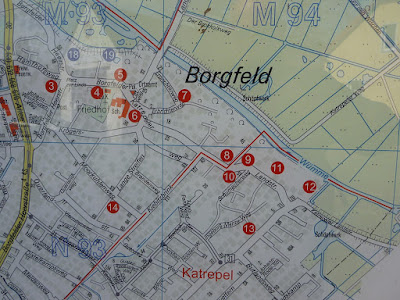 |
| Rhododendron 'Aprilmorgen'. Picture taken between rain showers on an April morning in 2016. |
 |
| Rhododendron-globe sculpture in Bremen's Rhododendron Park |
 |
| Terra Europa on rhododendron-globe sculpture |
 |
| Inflorescence of Rhododendron rubiginosum |
The ability of rhododendrons to resist cold differs from one species to another. As a result of horticultural nursing and research, ornamental rhododendrons with various degrees of winter hardiness now exist. Further, variations in flower color, size and shape have been realized in hybrid rhododendrons. For example, the Rhododendron 'Aprilmorgen' (April morning, see top picture) is a hybrid with pink flower buds, which open up as pink-white flowers that eventually turn completely white.
The Rhododendron 'Aprilmorgen' was introduced by the nursery Baumschule H. Hachmann in 2004 [4]. It is a Yakushimanum hybride, named after the Japanese Island of Yakushima, where the purebred plant, Rh. yakushimanum, grows in mountain areas at an elevation ranging from 1200 to 1800 m (3600 to 5400 feet). An information panel in the park with the title “Und noch mehr Yakushimamum-Rhododendron” (“Yet more Yakushimanum-Rhododendron”) explains that this species is favored in deriving hybrids, because it has a compact growth, rich flower display and excellent winter hardiness.
Getting to the Rhododendron Park
Take the tram from a downtown stop: BSAG Line 4 towards Borgfeld/Lilienthal. Exit at the Bürgergmeister-Spitta-Allee stop. You'll find yourself in the middle section of Schwachhauser Heerstraße. Use the pedestrian traffic signal to cross over to the south side of the street, turn left and cross Bürgergmeister-Spitta-Allee at the signal. Continue walking eastbound and turn right on Marcusallee. Continue on this street to its intersection with Deliusweg. Here you may either want to turn left and head to the Botanika (the “Green Science Center” [3]) and Botanical Garden section of the park or continue along Marcusallee until you arrive at the left-side semicircle, the main entrance (Haupteingang, see map below) of the Rhododendron Park. Note that there also is a bus option, Line 20, to get from the Bürgergmeister-Spitta-Allee/Schwachhauser Heerstraße junction to the main entrance.
The park is open from sunrise to sunset. Admission is free. Guided group tours are available.
 |
| Map of Bremen's Rhododendron Park |
References and more to explore
[1] Bremen Tourism: Rhododendron Park [www.bremen-tourism.de/rhododendron-park].
[2] Jon M. Valigorsky: Rhododendrons of North Germany. Journal American Rhododendron Society Fall 1986, 40 (4). EJournal access: scholar.lib.vt.edu/ejournals/JARS/v40n4/v40n4-valigorsky.htm.
[3] Botanika Bremen: www.botanika-bremen.de.
[4] Deutsche Genbank Rhododendron: Rhododendron 'Aprilmorgen', Hans Hachmann (1998)[www.bundessortenamt.de/rhodo/index.cfm?job=rhodo_one&rid=35603].
Grammar comment: On the rhododendron globe it says Verbreitung der Rhododendron auf der Erde. I would instinctively say Verbreitung der Rhododendren auf der Erde. Is it wright either way?
Further walking tours in Bremen
- Historic Borgfeld and the Hollerdeich with wetland vistas
- Friedrich-Bremermann-Weg alongside the Kuhgraben canal
- WWII Valentin submarine factory in Farge-Rekum
- Visiting a restored windmill in the Rekumer Geest
- Weser Rriver walk in Bremen-Vegesack































